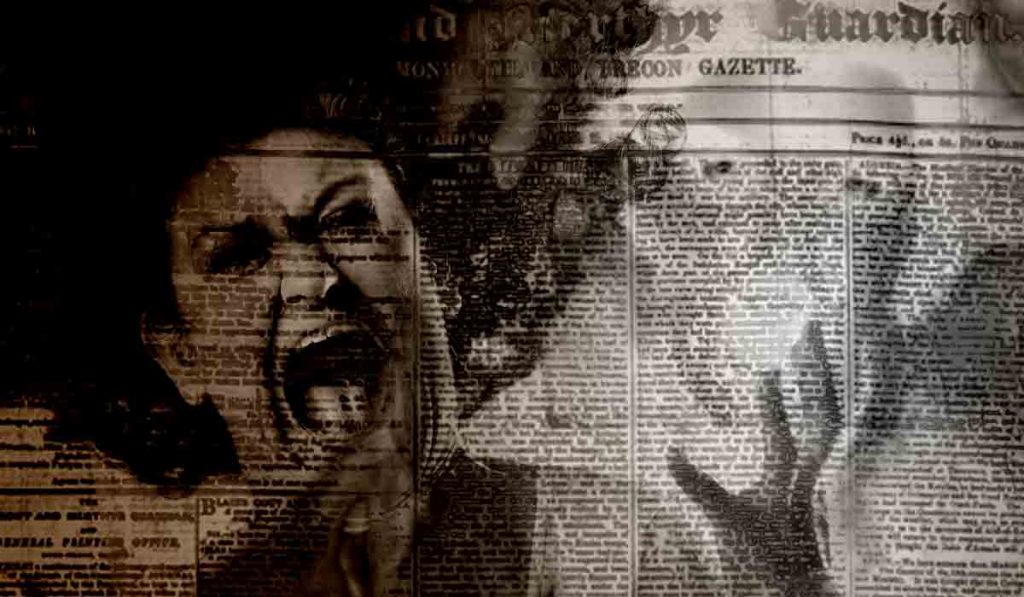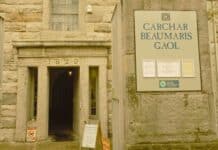ANDREW GARVEY goes hunting for some old paranormal articles from the Western Mail – Wales’ national newspaper

The Western Mail was founded in 1869 and is still running today – quite a feat for a regional newspaper. The daily tabloid that styles itself as Wales’ national paper has run plenty of supernatural-related stories over the years. As part of Spooky Wales Week, here’s just three from the Victorian era.
On 7th January 1885, the paper declared that:
“there are but few folks, in these days of practical science and negative theology, who care to be told that they have never out-grown the age of superstition. And yet that is so.
“Somewhere in all our economies there is hidden away a cherished belief in things for which our reason can find no foundation… Superstition is inherent to ninety-nine natures out of every hundred… Perhaps there is no nation more thoroughly superstitious than the Welsh, and yet there are no people to whom it is less harmful.
“Tradition has haunted every nook and corner of the Principality, and filled it with the ghosts of a glorious past. A primitive and poetical race must of necessity be deeply imbued with a love of the supernatural. A Welsh parish without a ghost is as rare a thing as a Welsh glen without its fairy ring; whilst the existence of corpse candles is, of course, as well authenticated as the electric light itself.”
Corpse Candles
Speaking of corpse candles (a common feature of Welsh mythology where a light like a candle was said to burn from the house where a death was about to occur), on 18th August 1885, in a story headlined THE CORPSE CANDLE AT TREFOREST the newspaper reported first hand on the debunking of an odd tale.
Apparently, mysterious lights above a local cemetery had caused people to gaze “at the distant mystery with horror. Fair eyes have been opened almost ‘as wide as saucers’ while the owners of those eyes have been heard to utter low moans as if under a mesmeric spell….”
Alone amongst the locals, one Mr. Tobin resolved to “interview the ghost, and to ask it a few pithy questions as to what it meant by its frightful antics….”
However, Tobin “did not carry out his intention, and the ghost was left to hold its nightly vigil among the tombs unmolested, and to frighten the whole neighbourhood.”
Eventually an expedition (including the author of the Western Mail article) ventured out at midnight to discover the light’s source. Beholding the light up close, one of the group was sent back to put out a nearby street’s gas light.
“We now watched intently the light in the cemetery. It disappeared with startling suddenness. We then ascertained that the light had been put out. It was presently re-lit, and the light in the cemetery, 400 yards away, re-appeared in the darkness at the same time.
Thus was the whole matter explained, it being nothing but the reflection of the distant gas light on the polished marble work on the summit of one of the tombs in the cemetery.”
Finally this week, under the headline ONLLWYN COLLIERS AND THE GHOSTS – MEN REFUSE TO WORK the 14th December 1895 Western Mail reported the following tale in a slightly sneering way (transcribed here in full):
“Our Neath representative writes: – According to information which reached me on Friday, the Onllwyn colliers have their own special ghosts. Two figures arrayed in befitting garments of white appeared at the entrance to the level on Thursday night, and several men, who were about to proceed to work, were so frightened that they actually dropped lamps and beat a precipitate retreat.
“The tale of the ghostly appearances rapidly spread, with the result that a body of men, whose belief in the supernatural must be stronger than their common sense, have increased the ranks of the indomitable six who first saw the uncanny apparitions.
“The managers of the colliery are of opinion that some mischievous spirits of substantial and earthly mould have been playing a practical joke, and last evening the police were on the watch in the hopes of arresting them and placing them under lock and key.”
Rotten spoilsports.
A Cyfarthfa Ghost Story – August 17th 1881
For the August 17th 1881 edition, the Mail’s anonymous but “esteemed correspondent” sent in an “extraordinary narrative” which he “vouched for on the most unimpeachable authority.”
The story concerns the dormant ironworks at Cyfarthfa, Merthyr Tydfil and although the Mail declared it’s scepticism it published anyway because “the story is a good one.” And it is, very nicely told.
The Ironworks – A Little History
First opened in 1765 by a London merchant, by the 1790s the Cyfathfa ironworks, under the direction of Richard Crawshay, became one of Britain’s most important iron producers – always handy for a nation almost perpetually at war somewhere in the world and in the midst of the industrial revolution.
The Crawshay family remained in charge, overseeing the works’ slow decline in the face of heavy foreign competition and rising costs. Still a hugely important local employer, profits from the ironworks were used to build William Crawshay II a grand home (Cyfarthfa Castle).
In 1875, the works closed, were re-opened and rebuilt to become a steelworks – a restructure that wasn’t completed until 1884, some time after the Western Mail’s story was published.
The Ghosts of Cyfarthfa Iron Works
The tale’s unnamed narrator begins by mysteriously half-explaining that he and a friend visited the works although why “must remain unexplained” and it was “towards the gloomiest part of the night that we sallied forth, and made our way over tramroads and intricate paths to the scene.”
From here, it’s worth simply quoting the rest of the correspondent’s description in full, reading as it does, like a classic Victorian ghost story a novelist might have conjured up.
“Cyfarthfa Works had been familiar to me for many years, but they were associated with the fullest activity, with the glare of furnaces, the whirl of the rolls; and that picture was vividly in my imagination when we stood at length before the works that were slumbering in thick darkness, and as silent as the grave.
No change could have been greater, no stillness more profound. We were far enough from the town to lose its glare and its noise, and out of the way of the people journeying from one place to another. No place could thus be more isolated, even as no contrast from the wild dash of work to the utter quietude could be more intense.
We stood a while just within the dense shadow of one of the mills, just tracing the ponderous wheels and the dimly outlined rolls when suddenly the two huge wheels creaked and began to revolve, the rolls to move, and in a moment there was all the whirl of industry again, only needing the glare of light and forms of men to assure us that the works were in full action.
My companion, with an exclamation of profound astonishment, clasped me by the arm. Cool, iron man as he is, strong-minded and proof against the superstitions of the age, I felt his voice tremble as he said, ‘This is most strange. There are no men here; the works are stopped; no steam, no motive power.’
And the grip on my arm became severe.
I, too, felt alarmed, and am not ashamed to confess it. My imagination, livelier than that of his, conjured up misty shades, and I saw shapes flitting to and fro, and heard the cry of men and boys amidst the clanging iron. Involuntarily we stepped back into the air, and as suddenly as the medley arose, so it died away; not a wheel moved, all was hushed, and at rest.”
The Old Man
“We walked away a little distance, our purpose unaccomplished, and talked to each other about this extraordinary incident. My friend, better able than I to afford a clue, was, like myself, utterly at sea, and could give no explanation. ‘But,’ said he, resolutely, ‘it must be fathomed, and we will find it out.’
With those words he hurried back to the works. I followed, and in a few minutes again stood looking into the silent mill. There was the same strange hush, the same weird gloom that appeared palpable did we but attempt to grasp it; but no sound.
‘Was it fancy?’ said my friend with his cheerful laugh. He had scarcely spoken when the great wheel again revolved, and machinery here and there, to the right, to the left, ponderous wheels and rolls, all sprang into motion, and the din of work was perfect in its fullness.
With this came the clanging of falling iron, the rattle of trams sounded strangely alike and again the impression was strong that puddlers and moulders flitted by, and ghostly labour went on. This was sufficient for us.
We hurriedly left the scene, and on our way home met one of the old ironworkers of Cyfarthfa to whom my friend related the circumstance. He knew the man as an old and respectable inhabitant, and made no secret of what we had heard.
‘Ha,’ said the veteran, stopping and leaning on his stick, ‘I have heard it too’: and, sinking his voice, he continued, ‘it always comes when the works are stopped.
It did one time before, many years ago, and when Mr Robert [Crawshay, died 1810] was living it came again. No one can say what is the reason, and perhaps it is best not to make any stir about it.’”
Printing the story in Wales’ biggest newspaper might count as a ‘stir’ but the Western Mail’s readers, whether sceptical or not, were treated, amongst such mundane, everyday headlines as ‘Sea Fishing at Aberystwyth‘, to a find old ghostly yarn.
Tell us your thoughts on these Victorian ghost stories in the comments below!








Hi
Me and my friend went to the castle yesterday and felt we were being watched,
Few orbs we seen and when we come out my friend took photos
Of us and the castle behind us.
Two photos had ghosts and the other one didn’t,.
The faces were above the blinds and the windows are massive so it was definitely not human.
Amazing photos
Hi Christine, sounds great – why not post the photos to our Facebook site: http://www.facebook.com/groups/spookyislesghosts/
It would be great to see them and see what other people think!